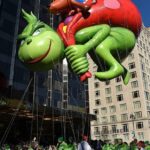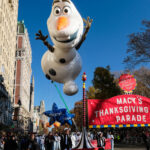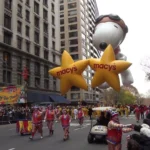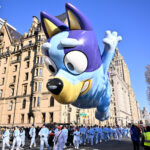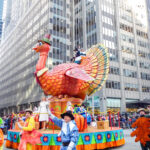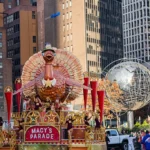Objectifs de communication :
- Comprendre et prendre part à une courte conversation sur un événement passé
Objectifs linguistiques :
- Be au prétérit
- Les défilés
- La prononciation de be au prétérit
Resources :
PDF: Macy’s Thanksgiving Parade Conversation – Questions
PDF: Macy’s Thanksgiving Parade Conversation – Answers
PDF: Prononcer correctement les grands nombres en anglais
PDF: It was magical! Worksheet
Contents
Macy's Thanksgiving Parade
1. Have a look at the photos and guess what American event is represented. Copy the vocabulary kit, and prepare a thirty-second presentation with your ideas.
Vocabulary kit
- float = char
- (giant) balloon = ballon (géant)
- band = fanfare
- flag bearer = porte-drapeau
- performers = artistes (chanteurs, danseurs…)
- spectators = spectateurs
- to march = défiler
I think that the event is …. because I can see lots of …. and ….
2. Copy the table below, then complete it using the text.
| Things you would like to know | Information |
|---|---|
| Name of the event | The Macy’s Thanksgiving Parade |
| Date | |
| Place | |
| What store sponsors this event? | |
| Number of people/spectators | |
| Length | |
| Composition |
The Macy’s Thanksgiving Parade
The Macy’s Thanksgiving Day Parade is an annual parade on Thanksgiving Day. It is sponsored by
Macy’s, the giant department store. It attracts more than 2.5 million people
to New York City and more than 44 million people watch the parade on television each year.
It lasts 3 hours and features balloons, floats, bands, and great performers.
| Things you would like to know | Information |
|---|---|
| Name of the event | Macy’s Thanksgiving Parade |
| Date | On Thanksgiving Day every year |
| Place | New York City |
| What store sponsors this event? | Macy’s, a department store |
| Number of people/spectators | More than 2.5 million people in the streets and more than 44 million TV viewers |
| Length | 3 hours |
| Composition | Balloons, floats, bands and performers |
Hazel and Emma
(Hazel and Emma are in Emma’s bedroom.)
Hazel: Are you ready to wake up early tomorrow?
Emma: But it’s Thanksgiving!
Hazel: Yes, and it’s Macy’s Parade. So we must be in Central Park at 6 am.
Emma: Really?
Hazel: Yeah, but it’s awesome. I love the giant balloons. Last year, my favourites were Spider-Man and the Minions. But I like Felix the Cat too because it was the first balloon created for the parade.
Emma: Oh, and when was the first parade?
Hazel: In 1924 but it was different. There were people dressed up in costumes and real animals from Central Park zoo. There weren’t any balloons at the origin.
Emma: And do you watch the parade every year?
Hazel: Yes, it’s like a tradition. And, look at the photo! Two years ago, I was in the parade with my school band.
Emma: Wow! How was it?
Hazel: It was magical! The weather was perfect and the parade was colourful and successful. There were 13 giant balloons, 24 floats and more than 800 clowns. And there were a lot of great artists like Lucy Hale, Kanye West or Beyoncé.
Emma: Cool!
Hazel: Yeah, and you know what? (showing Emma a photo) I have another picture with the beautiful singer Ariana Grande!
Emma: Lucky you!
Listen to the conversation between Hazel and Emma.
1. Listen and find out what Emma likes in the parade. Give precise examples.
2. Listen and make notes about the first parade (date, composition…).
3. Listen and find out more about the photos Hazel and Emma are looking at.
a. Pick out a date and explain where Hazel was.
b. Pick out adjectives to describe the event.
c. Give details about the composition of the parade.
d. Who is the girl in the photo? What do you know about her?
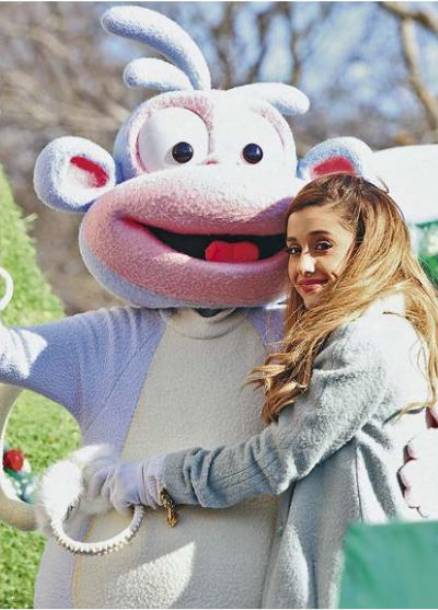
Listen to the conversation between Hazel and Emma.
1. Listen and find out what Emma likes in the parade. Give precise examples.
She loves the giant balloons. Last year, her favourites were Spider-Man, the Minions and she also likes Felix the Cat.
2. Listen and make notes about the first parade (date, composition…).
In 1924 – different – people dressed up in costumes – real animals from Central Park Zoo – no balloons
3. Listen and find out more about the photo Hazel and Emma are looking at.
a. Pick out a date and explain where Hazel was.
Two years ago, Hazel was in the parade with her school band.
b. Pick out adjectives to describe the event.
magical – colorful – successful – (perfect « weather! »)
c. Give details about the composition of the parade.
13 giant balloons – 24 floats – more than 800 clowns – a lot of great artists: Lucy Hale, Kanye West or Beyoncé
d. Who is the girl in the photo? What do you know about her?
It’s Ariana Grande. She’s an American singer (and actress).
Be au prétérit
1a. Observe et recopier ces phrases tirées du dialogue entre Hazel et Emma, dans chaque phrase, souligne les dates ou expressions de temps en vert.
- Last year, my favourites were Spider Man and the Minions.
- In 1924 but it was different.
- Two years ago, I was in the parade.
- Last year, my favourites were Spider Man and the Minions.
- In 1924 but it was different.
- Two years ago, I was in the parade.
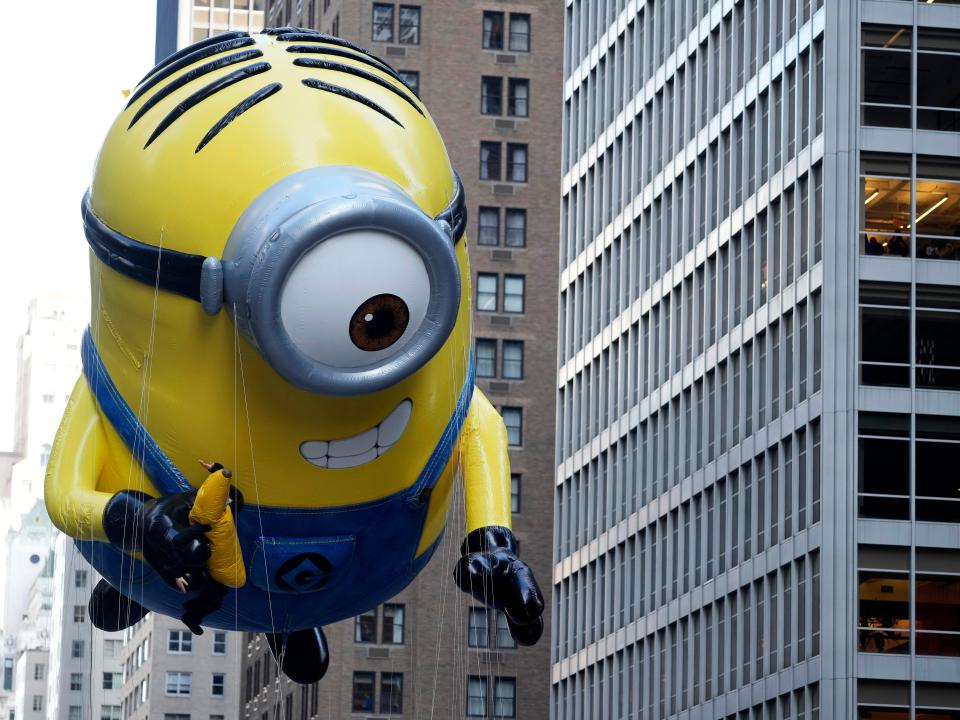
b. Recopie les phrases suivant avec les bonnes réponses.
- Les trois phrases renvoient à des événements passés / présents / futurs.
- Le verbe est donc conjugué au passé (prétérit) / présent / futur.
- Les trois phrases renvoient à des événements passés.
- Le verbe est donc conjugué au passé (prétérit).
c. Regarde les trois phrases. Souligne le groupe verbal en rouge. De quel verbe s’agit-il ?
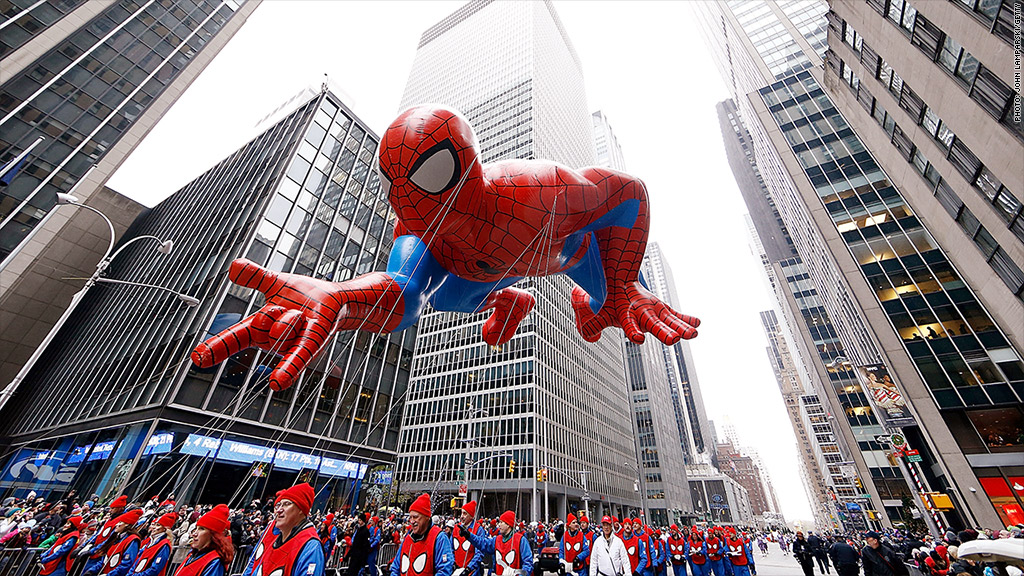
C’est le verbe « être/be »
- Last year, my favourites were Spider Man and the Minions.
- In 1924 but it was different.
- Two years ago, I was in the parade.
Grammar Kit.
Les deux formes de ………………………. au ………………………. sont :
………………………. (avec les sujets I/he/she/it) et
………………………. (avec les sujets we/you/they).
Grammar Kit.
Les deux formes de be au prétérit sont : was (avec les sujets I/he/she/it) et were (avec les sujets we/you/they).
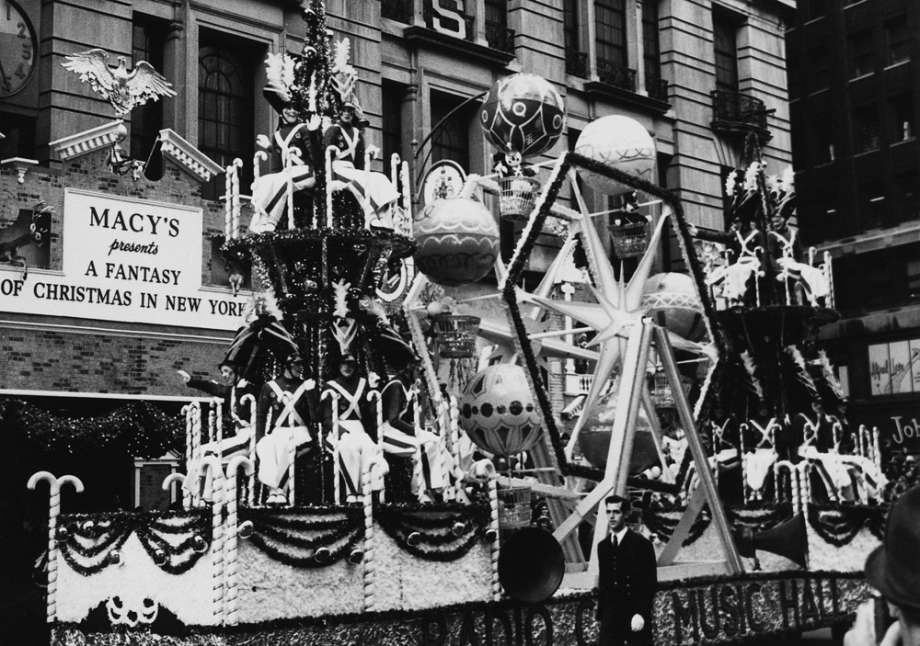
d. Recopier ce dialogue. Souligne le sujet en bleu, be en rouge et la négation en vert.
- « When was the first parade? » – « In 1924 but it wasn’t so big. »
- « How was it? » – « It wasn’t successful. »
- « When was the first parade? » – « In 1924, but it wasn’t so big. »
- « How was it? » – « It wasn’t successful. »
Grammar Kit.
Be est aussi un auxiliaire, il se suffit donc à lui-même. Ainsi pour poser une question avec be au prétérit, on ………………………. simplement be conjugué et le sujet. À la forme négative, on ajoute ………………………. ou sa forme contractée ………………………. à be conjugué.
Grammar Kit.
Be est aussi un auxiliaire, il se suffit donc à lui-même. Ainsi pour poser une question avec be
au prétérit, on inverse simplement be conjugué et le sujet. À la forme négative,
on ajoute not ou sa forme contractée n’t à be conjugué.
2a. Recopie les phrases et complète avec la bonne réponse.
- In 1927, there was one giant balloon.
- In 2015, there were ten giant balloons.
Ces deux phrases font référence au passé / présent / futur.
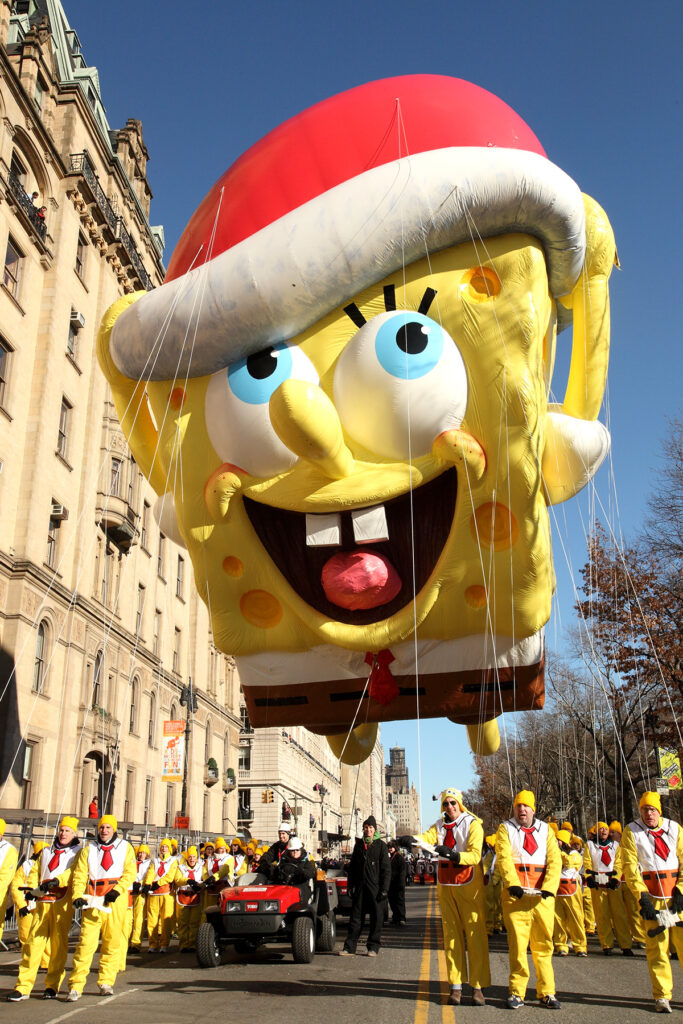
Ces deux phrases font référence au passé.
Grammar Kit.
Pour parler de l’existence de quelque chose dans le ………………………., on utilise ……………………….
suivi de ………………………. conjugué au ………………………. .
Be s’accorde / ne s’accorde pas en nombre avec le nom qui suit.
Exemples : There ………………………. a Snoopy balloon.
There ………………………. three Disney balloons.
Pour parler de l’existence de quelque chose dans le passé, on utilise there suivi de be conjugué au prétérit.
Be s’accorde en nombre avec le nom qui suit.
Exemples : There was a Snoopy balloon. There were three Disney balloons.
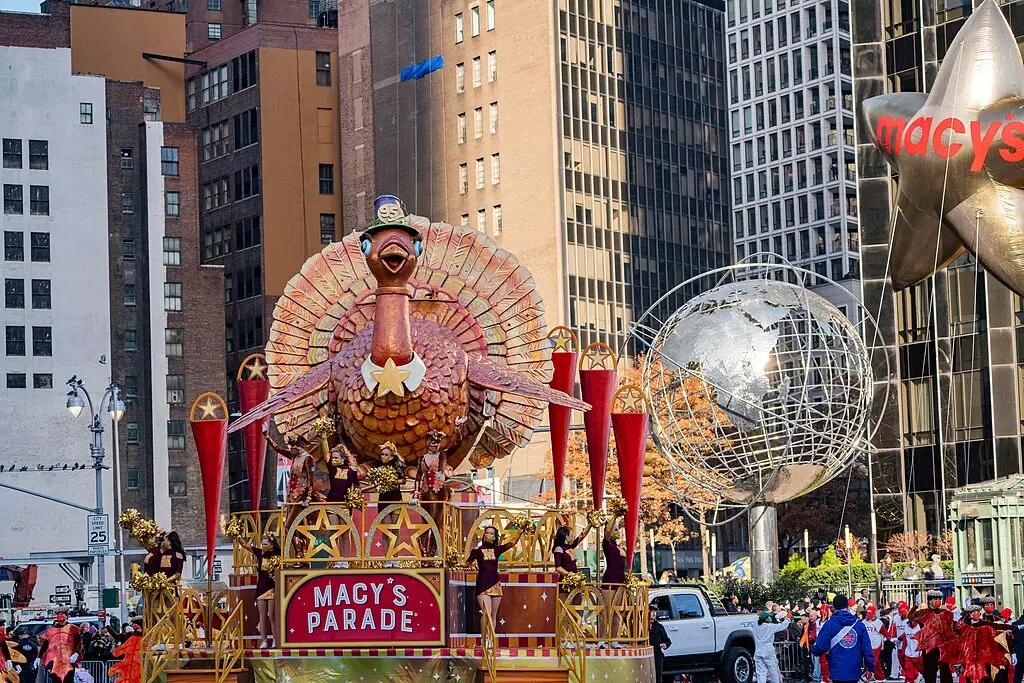
b. Dans la phrase ci-dessous, souligne there en bleu et be en rouge.
- How many balloons were there in 1924?
- There weren’t any balloons.
- How many balloons were there in 1924?
- There weren’t any balloons.
c. Observe l’ordre des mots dans la question et complète.
Pour poser une question sur l’existence de quelque chose dans le passé, on inverse ________ et ________.
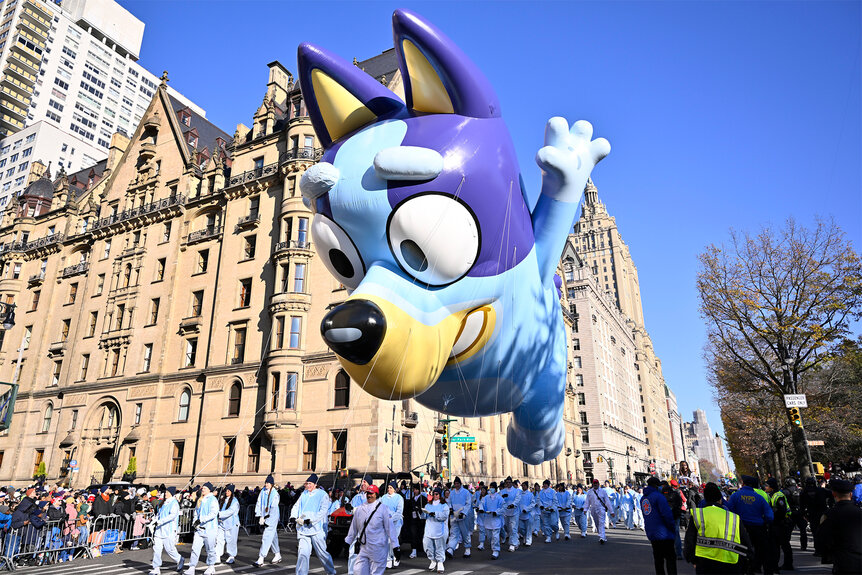
Pour poser une question sur l’existence de quelque chose dans le passé, on inverse there et be.
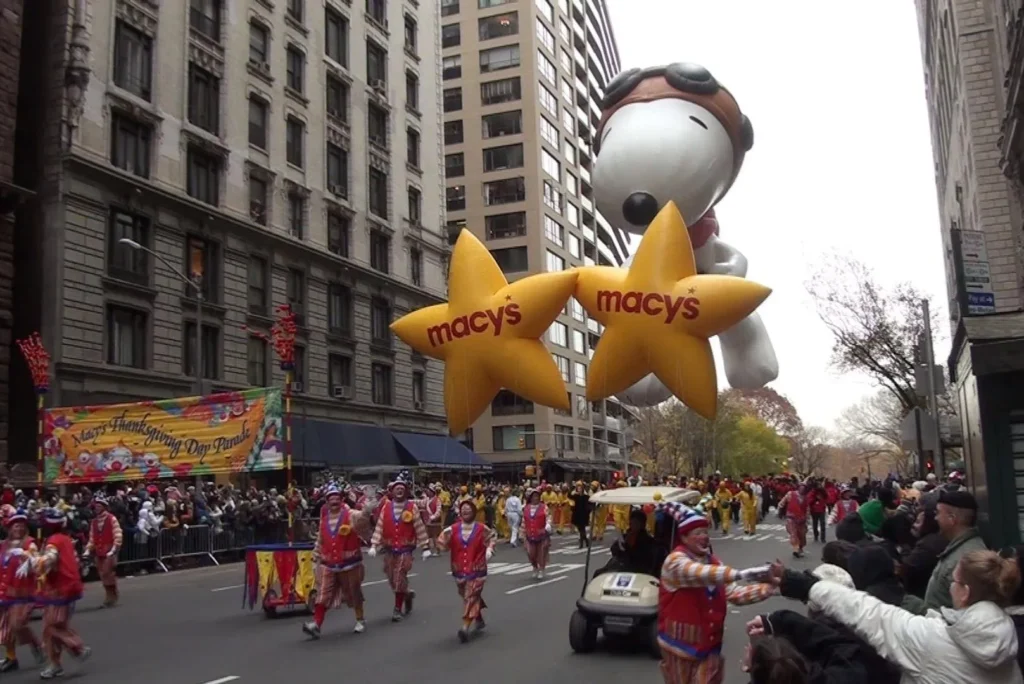
d. Observe la réponse à la question et complète.
Pour dire que quelque chose n’existait pas dans le passé, on ajoute ________ ou sa forme contractée ________ à be conjugué.
Pour dire que quelque chose n’existait pas dans le passé, on ajoute not ou sa forme contractée n’t à be conjugué.
Grammar Kit.
Dans une phrase négative, pour indiquer l’absence de quelque chose, on ajoute any avant le nom.
Exemple : There weren’t any balloons.
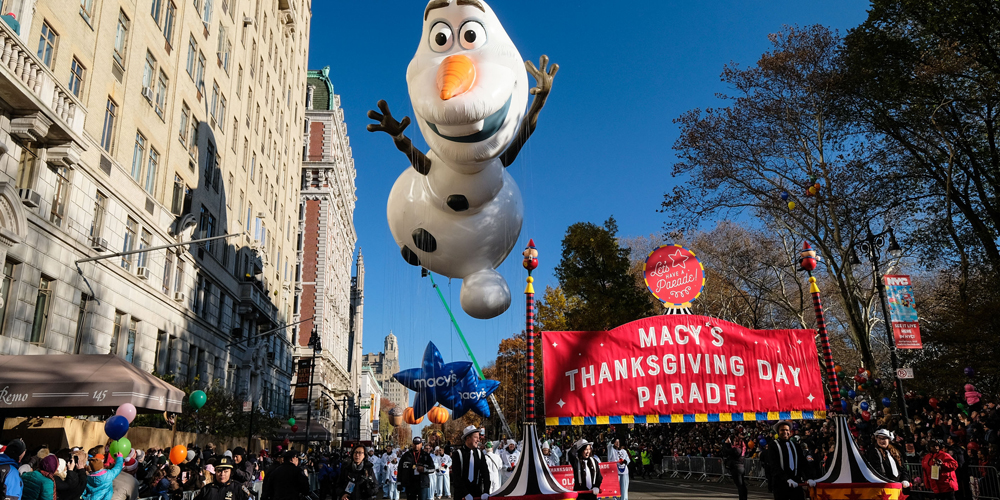
Interacting
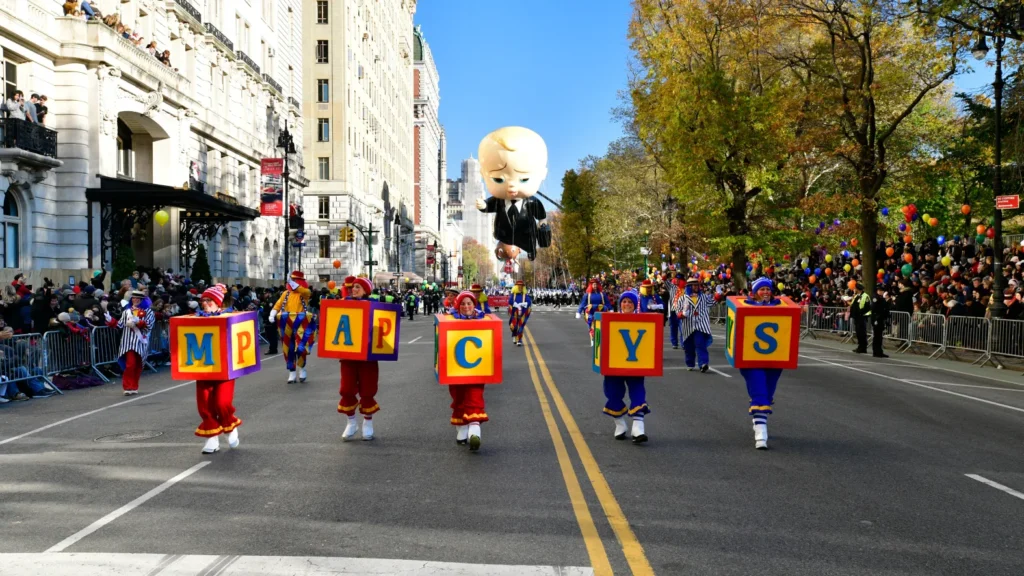
Vous allez échanger des informations sur la parade avec votre ami
1. Prepare les questions.
Complète les questions en utilisant les informations, le mot interrogatif et le verbe « be ». Do you remember how to pronounce dates?
- Original name of the parade. (what) – What was the original name of the parade?
- Animals in the parade in 1924. (which animals) – Which animals were in the parade in 1924?
- Number of giant balloons in 1924. (how many) – How many giant balloons were there in 1924?
- Number of giant balloons in 1927. (how many)
- Number of new giant balloons in 2014. (how many)
- Number of giant ballons in 2013. (how many)
- Name of the new giant balloon in 1934. (what)
- Number of spectators in 1924. (how many)
- Number of spectators in 2014. (how many)
- Major artists in 2006. (what)
- Number of bands in 2015. (how many)
- Number of floats in 2015. (how many)
- What was the original name of the parade?
- Which animals were in the parade in 1924?
- How many giant balloons were there in 1924?
- How many giant balloons were there in 1927?
- How many new giant balloons were there in 2014?
- How many giant balloons were there in 2013?
- What was the name of the new giant balloon in 1934?
- How many spectators were there in 1924?
- How many spectators were there in 2014?
- What were the major artists in 2006?
- How many bands were there in 2015?
- How many floats were there in 2015?
2. Prononcer correctement les grands nombres en anglais
En anglais, les grands nombres se prononcent différemment du français. Voici quelques règles essentielles :
- Les centaines : on dit le chiffre suivi de « hundred » sans ajouter « and ».
Exemple : 100 = one hundred, 500 = five hundred.
- Les centaines avec des dizaines et unités : on ajoute « and » après « hundred » pour relier les dizaines et unités.
Exemple : 125 = one hundred and twenty-five.
- Les milliers (4 chiffres) : on dit le chiffre suivi de « thousand ».
Exemple : 1 000 = one thousand, 3 500 = three thousand five hundred.
- Les nombres entre 1 000 et 9 999 : pas de « and » entre le millier et le reste du nombre.
Exemple : 4 275 = four thousand two hundred and seventy-five.
- Les nombres à cinq chiffres (10 000 à 99 999) : on annonce les dizaines de milliers suivies du reste du nombre.
Exemple : 25 000 = twenty-five thousand, 42 680 = forty-two thousand six hundred and eighty.
- Les nombres à six chiffres (100 000 à 999 999) : on annonce les centaines de milliers suivies du reste du nombre.
Exemple : 100 000 = one hundred thousand, 275 430 = two hundred and seventy-five thousand four hundred and thirty.
- Un million : on dit simplement one million.
Exemple : 1 000 000 = one million, 2 500 000 = two million five hundred thousand.
🔹 Attention : En anglais, il n’y a pas de « s » à « hundred », « thousand » ou « million » quand ils sont précédés d’un nombre précis (ex. three hundred).
Mais on peut dire hundreds of, thousands of pour exprimer une quantité approximative.
Worksheet
Evaluation
Complete the It was magical! evaluation.
